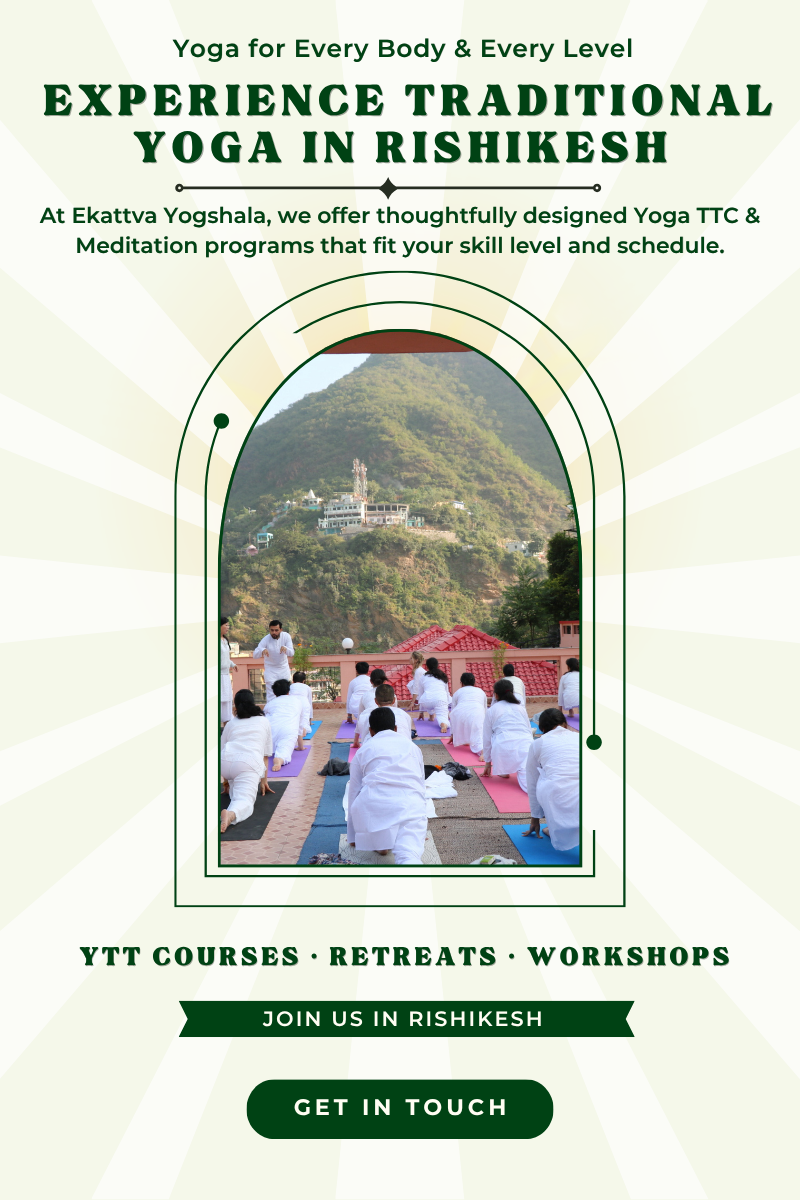Different Types of Pranayama and How to Perform Them
Pranayama is widely recognized worldwide for its profound effects on physical, mental, and spiritual well-being. It is considered a pivotal component of yoga as it harmonizes mind, body, and spirit, and facilitates profound inner transformation. But do you know that pranayama can be practised using different types of techniques?
In this blog, Ekattva Yogshala - renowned yoga school in Rishikesh - will reveal the diverse types of pranayama and guide you on how to perform them. Whether you’re a beginner or an experienced practitioner, understanding these different breathing exercises will empower you to harness the immense benefits of this ancient yogic practice.
Here are different types of pranayama techniques to enhance your overall health and vitality:
#1 Anulom Vilom
Anulom Vilom is a balancing pranayama practice that involves breathing through alternate nostrils. It purifies the nadis (energy channels) and brings equilibrium to the body and mind. Practicing Anulom Vilom regularly can also improve respiratory health, enhance focus, reduce stress, and increase mental clarity.
Here are steps to perform this type of pranayama technique:
Sit comfortably in a meditative posture.
Close your eyes and relax.
Place your right thumb on the right nostril and inhale slowly through the left nostril.
Now close the left nostril with your ring finger and exhale through the right nostril.
Inhale through the right nostril, close it, and exhale through the left nostril.
Repeat this cycle for a few minutes, gradually increasing the duration.
#2 Kapalabhati
Also known as skull-shining breath, Kapalabhati is an invigorating pranayama technique that involves forceful exhalation followed by passive inhalation. Not only can it help you cleanse the respiratory system but also boost metabolism, improve digestion, and energise the mind.
The following are the steps to practice this type of pranayama:
Sit with an upright spine and relax your shoulders.
Take a deep inhalation through both nostrils.
Quickly contract your abdominal muscles to forcefully exhale through the nostrils.
Allow the inhalation to happen passively without effort.
Repeat this rapid exhalation and passive inhalation for a few rounds, increasing the pace slowly.
An ultimate guide on breathwork for anxiety
#3 Bharmi pranayama
Okay, we all know how bees buzz. Our next type of pranayama captures that essence by involving a gentle humming sound during exhalation. Bharmi Pranayama, also popularly known by the name Bee Breath, can be performed to calm our senses. It can also help in reducing stress and anxiety and improve concentration and focus.
Here are steps to perform this type of pranayama technique on your own:
Sit in a comfortable seated position.
Close your eyes. Take a few deep breaths to relax.
Now place your index fingers gently on your ear cartilage.
Take a deep breath in and exhale slowly while making a gentle humming sound like a bee.
Feel the vibrations in your head and body.
Repeat for several rounds, focusing on the sound and sensation.
#4 Sheetali pranayama
Another popular pranayama type to perform in 2023. Sheetali pranayama is basically a pranayama technique that involves inhaling through a rolled tongue or by creating a straw-like shape with the mouth. Not only it helps in reducing body heat but also in calming down the mind and relieving stress and tension.
The following are steps for practicing Sheetali pranayama:
Sit comfortably and relax your facial muscles
Roll your tongue and extend it slightly outside the mouth.
Now inhale slowly and deeply through rolled tongue.
Close your mouth and exhale through your nose.
Repeat for several rounds. Enjoy the cooling sensation with each inhalation.
There you go!
We told you about different types of pranayama techniques. Regular practice of these can lead to profound physical, mental, and spiritual benefits, promoting overall well-being. Just make sure to practice pranayama under the guidance of a qualified yoga instructor, especially if you’re a beginner or have any health concerns.
To set a strong foundation for your pranayama practice, consider joining Ekattva Yogshala's online breathwork classes. Our experienced teachers will provide expert guidance, helping you cultivate a safe and effective pranayama routine.
Embrace the power of breath and embark on a journey of self-discovery and holistic wellness with Ekattva. Send us an email at info@spiritualpunditz.com in case of queries!
Also, read:
Learn about bandhas for beginners
Beginners guide on Ashtanga yoga practice
6 best positions for practicing meditation in 2023
Set up a morning breathwork routine


